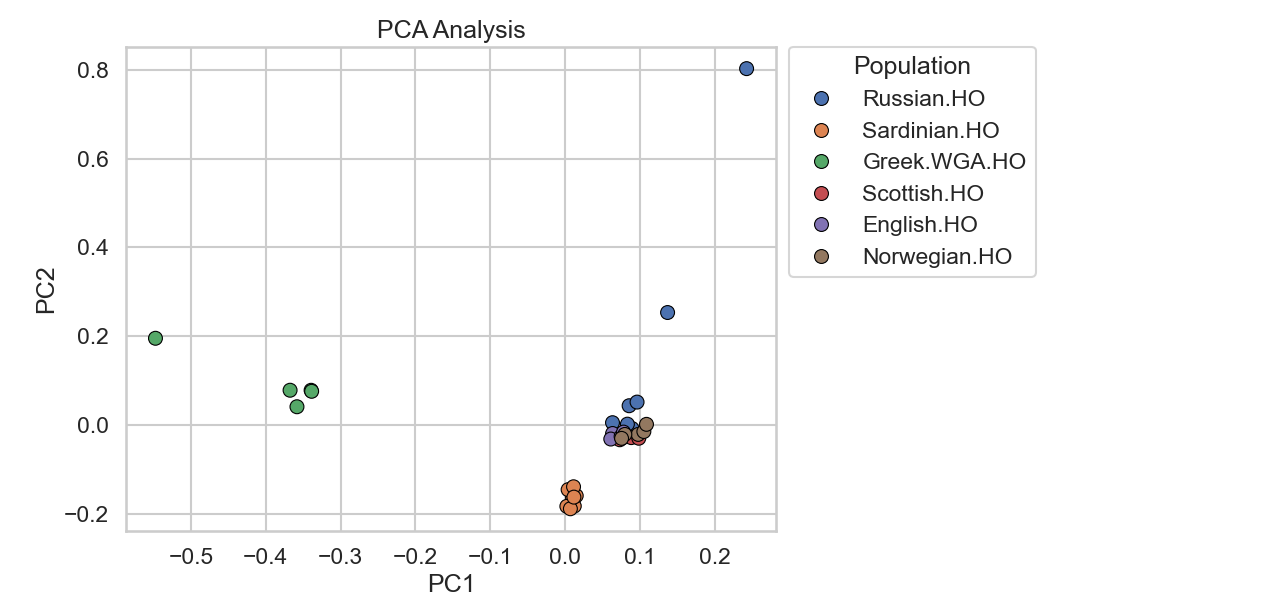This post is a continuation of the previous one, where I demonstrated how to perform PCA with PLINK. While PLINK’s PCA is great for quick, exploratory analysis, smartpca (part of the EIGENSOFT toolset) is more commonly used in published genetic studies.
Smartpca needs to be compiled on Linux or macOS. I covered how to install and prepare the toolchain on Linux in this earlier post: From EIGENSTRAT to PACKEDPED.
As before, I’ll use a small subset. The focus here is on the technical process, not on interpreting the results. One key difference in this post is that I’ll perform Linkage Disequilibrium (LD) pruning, which helps reduce SNP redundancy and improves the detection of population structure in PCA.
LD Pruning
# Window size: 50 SNPs
# Step size: 5 SNPs
# LD threshold: r² > 0.2 will be pruned
plink --bfile input --indep-pairwise 50 5 0.2
# Extract the pruned SNPs into a new dataset
plink --bfile input --extract plink.prune.in --make-bed --out pruned_data
Note: If you’re working with low-coverage ancient samples, applying LD pruning directly to a mixed dataset (modern + ancient) may introduce bias, since SNP retention will favor samples with higher coverage. A better approach:
- Prune only the modern dataset.
- Use the same pruned SNP list (
plink.prune.in) to extract SNPs from the ancient dataset. - Merge both datasets.
Here’s how you can do that:
# Step 1: Prune modern samples
plink --bfile modern --indep-pairwise 50 5 0.2
# Step 2: Create pruned datasets for both groups
plink --bfile modern --extract plink.prune.in --make-bed --out pruned_modern
plink --bfile ancient --extract plink.prune.in --make-bed --out ancient_extracted
# Step 3: Merge datasets
plink --bfile pruned_modern --bmerge ancient_extracted --make-bed --out final
Converting the Dataset to EIGENSTRAT Format
Smartpca requires data in EIGENSTRAT format. Assuming your merged/pruned data is in PACKEDPED (.bed/.bim/.fam) format, you can use convertf (part of EIGENSOFT) to convert it.
Create a parameter file named convert (or a name of your choice, adjust the parameters accordingly) with the following content:
genotypename: final.bed
snpname: final.bim
indivname: final.fam
outputformat: EIGENSTRAT
genotypeoutname: pca.geno
snpoutname: pca.snp
indivoutname: pca.ind
Now run:
convertf -p convert
This will generate the three required input files for smartpca: pca.geno, pca.snp, and pca.ind.
Creating the Smartpca Parameter File
Like most Reich Lab tools, smartpca uses a parameter file to specify input and output options. Here’s a minimal example:
genotypename: pca.geno
snpname: pca.snp
indivname: pca.ind
evecoutname: pca.evec
evaloutname: pca.eval
altnormstyle: NO
numoutevec: 10
numoutliter: 0
lsqproject: YES
numthreads: 5
lsqproject: YES enables projection mode, meaning projected samples don’t influence the PCA axes. In this example, all samples are high-coverage modern individuals, so projection isn’t technically needed—but I demonstrate it here for completeness. Save the parameter file with a name like pca_param (no extension).
To project samples, you’ll need to modify the .ind file of your EIGENSTRAT dataset. Change the third column from Case to P:
...
2032:TLA018.HO M Case
2033:TLA019.HO M P
2034:TLA020.HO M Case
...
Running Smartpca
Now we run smartpca with:
smartpca -p pca_param
This generates two files: pca.eigenval (lists how much variance each eigenvector explains) and pca.evec (contains sample IDs and principal component values).
Preparing for Plotting
To make the output compatible with the plotting script from the previous post, convert the .evec file to CSV:
awk '{ $NF=""; sub(/[ \t]+$/, ""); gsub(/[ \t]+/, ","); print }' pca.evec > smartpca.csv
Then, open the resulting file and manually delete the first line (which begins with #eigvals).
Final Plot
After loading the cleaned CSV into the plotting script, this is the resulting plot for my subset:
